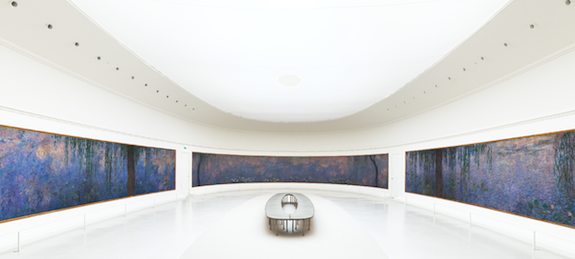Some have anachronistically compared the cyclorama to the tradition of filmmaking. While the mass appeal of cyclorama may have anticipated public fascination with audiovisual immersion, the filmic perspective does not follow from the cycloramic perspective. Theatricality, Michael Fried's argument against minimalism, would prove latent in the cyclorama: viewers were not absorbed in contemplation of the visual, but immersed in a production of theater in the round. Indeed, the cyclorama requires a specific architecture and a viewer-centric mode of hanging; the paintings are foregrounded by pastoral assemblage and the painted battle scenes augmented by the sound and smoke of replicated cannon. Installed as such, the cyclorama operates more as a detailed backdrop for a production than a painting worthy of formal contemplation. The Battle of Atlanta in particular amplifies the way that cyclorama painting deviated from single-point perspective (the Renaissance innovation of centering the eye of the beholder within the painting's imagined horizon), instead relying on a hyperbolic hanging structure to give the illusion of three-dimensional depth.
To contrast with cyclorama, I present two cycles of art historical painting, Claude Monet's Water Lilies and Mark Bradford's Pickett's Charge. Both cycles consist of eight monumental canvases, housed in curvilinear galleries. The former hang as a cycle in a series of two ellipses at the Orangerie in Paris; the latter in a gallery shaped like a hollow cylinder, the Hirshhorn in Washington, DC. In distinguishing the "cycle" from "cyclorama," my analysis seeks to include, rather then exclude, canonical examples of cyclical work.such as Cy Twombly's Battle of Lepanto, a cycle of 12 canvases hung in a custom gallery in the Prado, occupy similar art historical territory as the Monet and Bradford cycles.
 Claude Monet, The Water Lilies: Setting Sun, donated to Musée de l'Orangerie 1922. http://www.musee-orangerie.fr/en/article/set-orangerie
Claude Monet, The Water Lilies: Setting Sun, donated to Musée de l'Orangerie 1922. http://www.musee-orangerie.fr/en/article/set-orangerie

Claude Monet, The Water Lilies [installation view], 1915-1926. http://www.musee-orangerie.fr
When Monet set out en plein air to capture the reflections of his beloved garden pond at Giverny, he developed a perspective of his own, later dubbed "all-over" painting. Monet's canvases reflected nature without any discernible hierarchy or perspective. One wonders if, on a different day, in another light, a ripple may alter the surface or a reflection appear. These canvases appear as the surface of water itself, forever tranquil and smooth.
The Orangerie contributes to the sense of tranquility. Designed by Monet, everything about the space, from the rhythm of the paintings, to the shape of the galleries, to the use of natural light enhances the cycle of paintings. The objects themselves are the subjects worthy of deep contemplation, and set in a space designed to enhance their absorptive properties. Examples of Monet's Water Lilies hang in galleries all over the world; yet it is only at the Orangerie that they hang as a cycle.
Once inside the Orangerie, the eight Water Lilies are hung in two elliptical galleries, which are joined at the narrowest point. Natural light bathes the two rooms from elliptical skylights above and floor-to-ceiling windows at the juncture of the galleries. The paintings are not only hung rhythmically, but also oriented to nature: the image of the pond at sunrise occupies the eastern wall, sunset hangs on the west. Benches invite contemplation of individual canvases, but movement is essential: the beholder must traverse the gallery space to activate the cycle, and the beholder's path traces the shape of infinity. This movement of the beholder may be a nod the artist's affinity for Japanese zen gardening, the monk's rosaire, or perhaps even the urban flâneur. The shape of the galleries invite the beholder to consider the Water Lilies in an infinite loop.

Mark Bradford, Pickett's Charge: Copse of Trees, 2017. http://www.historynet.com/new-charge-mark-bradfords-picketts-charge.htm

Mark Bradford, Pickett's Charge [detail], 2017. http://hirshhorn.si.edu/exhibitions/mark-bradford-picketts-charge/
While Monet's decentralized, "all-over" style makes the canvas into a plane, as if becoming the surface of water itself, Mark Bradford's dense layers emerge and retreat through the canvas, hinting at a space hidden from view, unseen, inaccessible. Perhaps Bradford has plunged into Monet's pond, and, expecting water, found Ralph Ellison's space "outside of history" instead.
While Bradford explicitly claims the depiction of battle as his subject, the work itself bears little resemblance the the Gettysburg cyclorama. The abstracted canvases, covered in a collage of paint, rope, and gigantic reproductions of Philippoteaux's Battle of Gettysburg on billboard paper, resemble a timeline or a histomap more than the raw material of the cyclorama.
The Hirshhorn gallery is likewise dissimilar to its cycloramic antecedent. In the words of Mark Bradford, "With cycloramas, the viewer stands in the middle — you’re omniscient. In the Hirshhorn, you can’t stand in the middle —you’d fall right through." Just as the space at the center of the Hirshhorn is inaccessible, so too is omniscience. As much as the tableau itself, Bradford asks the beholder to consider what lies beyond the canvas.
The American Civil War remains “the most divisive and unresolved experience Americans have ever had,” according to historian David Blight. Monet has no use for spaces "outside of history;" his Water Lilies cycle prescribes infinite absorption into the sublime. Yet until the memory and the history of America's bloody internecine conflict reach an equilibrium of truth, narratives of the American Civil War will continue to be as layered as Mark Bradford's canvases, and omniscience as impossible as standing at the center of the Hirshhorn.
To contrast with cyclorama, I present two cycles of art historical painting, Claude Monet's Water Lilies and Mark Bradford's Pickett's Charge. Both cycles consist of eight monumental canvases, housed in curvilinear galleries. The former hang as a cycle in a series of two ellipses at the Orangerie in Paris; the latter in a gallery shaped like a hollow cylinder, the Hirshhorn in Washington, DC. In distinguishing the "cycle" from "cyclorama," my analysis seeks to include, rather then exclude, canonical examples of cyclical work.such as Cy Twombly's Battle of Lepanto, a cycle of 12 canvases hung in a custom gallery in the Prado, occupy similar art historical territory as the Monet and Bradford cycles.

Claude Monet, The Water Lilies [installation view], 1915-1926. http://www.musee-orangerie.fr
When Monet set out en plein air to capture the reflections of his beloved garden pond at Giverny, he developed a perspective of his own, later dubbed "all-over" painting. Monet's canvases reflected nature without any discernible hierarchy or perspective. One wonders if, on a different day, in another light, a ripple may alter the surface or a reflection appear. These canvases appear as the surface of water itself, forever tranquil and smooth.
The Orangerie contributes to the sense of tranquility. Designed by Monet, everything about the space, from the rhythm of the paintings, to the shape of the galleries, to the use of natural light enhances the cycle of paintings. The objects themselves are the subjects worthy of deep contemplation, and set in a space designed to enhance their absorptive properties. Examples of Monet's Water Lilies hang in galleries all over the world; yet it is only at the Orangerie that they hang as a cycle.
Once inside the Orangerie, the eight Water Lilies are hung in two elliptical galleries, which are joined at the narrowest point. Natural light bathes the two rooms from elliptical skylights above and floor-to-ceiling windows at the juncture of the galleries. The paintings are not only hung rhythmically, but also oriented to nature: the image of the pond at sunrise occupies the eastern wall, sunset hangs on the west. Benches invite contemplation of individual canvases, but movement is essential: the beholder must traverse the gallery space to activate the cycle, and the beholder's path traces the shape of infinity. This movement of the beholder may be a nod the artist's affinity for Japanese zen gardening, the monk's rosaire, or perhaps even the urban flâneur. The shape of the galleries invite the beholder to consider the Water Lilies in an infinite loop.
Mark Bradford, Pickett's Charge: Copse of Trees, 2017. http://www.historynet.com/new-charge-mark-bradfords-picketts-charge.htm

Mark Bradford, Pickett's Charge [detail], 2017. http://hirshhorn.si.edu/exhibitions/mark-bradford-picketts-charge/
While Monet's decentralized, "all-over" style makes the canvas into a plane, as if becoming the surface of water itself, Mark Bradford's dense layers emerge and retreat through the canvas, hinting at a space hidden from view, unseen, inaccessible. Perhaps Bradford has plunged into Monet's pond, and, expecting water, found Ralph Ellison's space "outside of history" instead.
While Bradford explicitly claims the depiction of battle as his subject, the work itself bears little resemblance the the Gettysburg cyclorama. The abstracted canvases, covered in a collage of paint, rope, and gigantic reproductions of Philippoteaux's Battle of Gettysburg on billboard paper, resemble a timeline or a histomap more than the raw material of the cyclorama.
The Hirshhorn gallery is likewise dissimilar to its cycloramic antecedent. In the words of Mark Bradford, "With cycloramas, the viewer stands in the middle — you’re omniscient. In the Hirshhorn, you can’t stand in the middle —you’d fall right through." Just as the space at the center of the Hirshhorn is inaccessible, so too is omniscience. As much as the tableau itself, Bradford asks the beholder to consider what lies beyond the canvas.
The American Civil War remains “the most divisive and unresolved experience Americans have ever had,” according to historian David Blight. Monet has no use for spaces "outside of history;" his Water Lilies cycle prescribes infinite absorption into the sublime. Yet until the memory and the history of America's bloody internecine conflict reach an equilibrium of truth, narratives of the American Civil War will continue to be as layered as Mark Bradford's canvases, and omniscience as impossible as standing at the center of the Hirshhorn.
John B. Sparks, Histomap, 1931. http://www.openculture.com/2013/10/4000-years-of-history-in-histomap-from-1931.html
Bibliography
Blight, David. Race and Reunion: The Civil War in American Memory. Cambridge, MA: Harvard University Press, 2001.
Dingfelder, Sadie. "Artist Mark Bradford explains his Hirshhorn remix of a Civil War painting." Washington Post. 7 November 2017. www.washingtonpost.com/express/wp/2017/11/07/artist-mark-bradford-explains-his-hirshhorn-remix-of-a-civil-war-painting
Ellison, Ralph. Invisible Man. New York, NY: Random House, 1952.
Fried, Michael. Absorption and Theatricality: Painting and Beholder in the Age of Diderot. Chicago, IL: University of Chicago Press, 1988.
Greenberg, Clement. "Modernist Painting." Voice of America Forum Lectures. Washington, DC: U.S. Information Agency, 1960.
Summers, David. Real Spaces: World Art History and the Rise of Western Modernism. London: Phaidon, 2003.
